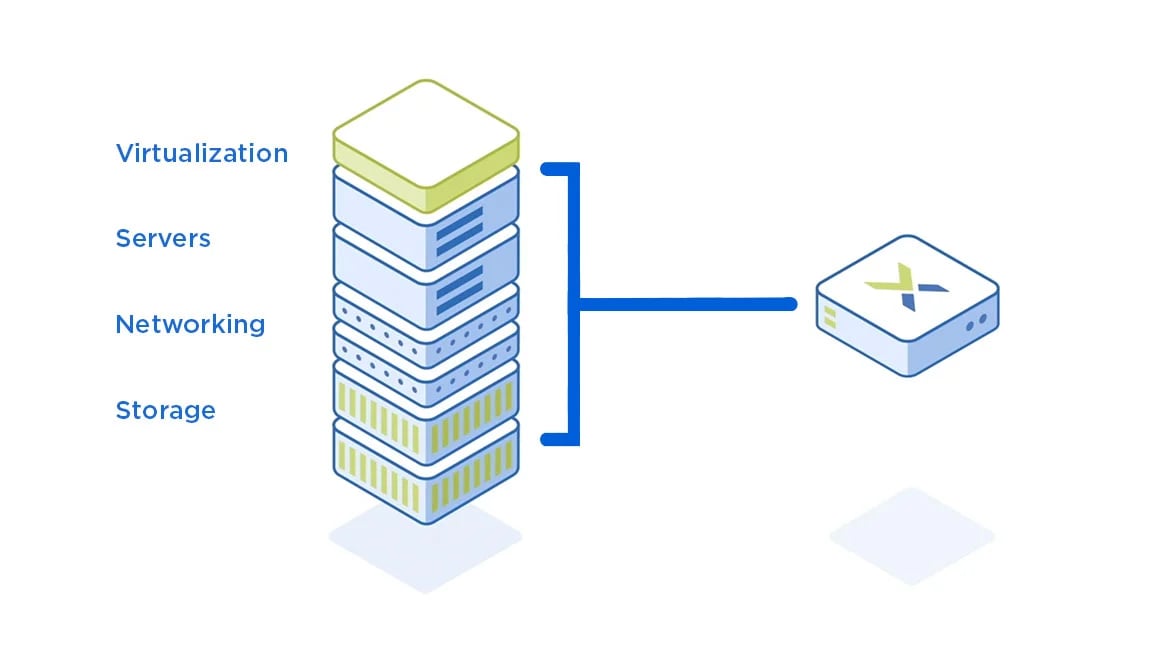Is your technology a cobbled mess of servers, storage, networking and more? Does it keep growing in complexity and take too much time to manage and keep it all straight? If so, you’re not alone.
That’s why the popularity of hyperconverged infrastructure (HCI) just keeps growing. Analysts predict the global HCI market will expand to $36.56 billion by 2025 with an astounding CAGR of almost 26%.
Is this a bandwagon your business should jump on? Let’s explore what HCI is and how hyperconverged solutions can benefit your business.
What is Hyperconverged Infrastructure (HCI)?
Before HCI came on the scene, the standard set-up in most data centers was a tiered architecture that included independent modules on separate platforms. These various platforms might include management, servers, storage, networking and virtualization.
An HCI solution leverages software to combine and streamline the various building blocks of a traditional data center into a single stack on a single platform. This drastically streamlines and simplifies the management of your data center.
RELATED: Hyperconverged Infrastructure — What to Expect

What are the Key Benefits of Hyperconverged Infrastructure?
Reduced Complexity
Because the main components in a tiered architecture are separate, you’re mixing different technology stacks in your data center. It requires a lot of hardware and it’s much more difficult to manage. Even something as essential as adding storage can take days or weeks because you have to make upgrades across a variety of components from different manufacturers.
As a single stack solution, HCI requires far less physical hardware and is quite easy to manage. Upgrading the system is a snap or, more accurately, a click. Everything within an HCI system is built by a single manufacturer and is managed from a single dashboard. With the click of a button, you can upgrade your entire data center – software, firmware, networking and all – with no interruptions to your end users.
VIEW CASE STUDY: Budget-friendly HCI System Streamlines Data Center
Easier Troubleshooting
In a tiered system, troubleshooting is challenging because you have to move between separate management interfaces for the different components. If you end up needing vendor support, you have to coordinate with multiple vendors to track down issues across your servers, storage and networking components.
HCI is a homogeneous system from one manufacturer. You only have to work with one management interface and a single vendor, making finding and solving problems faster and a lot less stressful.
Cohesive Disaster Recovery & Business Continuity
HCI systems are purpose-built to provide great data protection and disaster recovery (DR). Built-in software synchronizes your workloads, applications, file storage and more between your main facility and a DR node at another location. That way, if there’s a disaster at your main data center, the offsite DR node can continue powering your business. This redundancy gives you excellent resiliency in the case of a cyberattack or other emergency.
What are Common Use Cases for HCI?
Of course, there are many more benefits of HCI. For starters, you don’t need hundreds of virtual machines or a gigantic network in order for HCI to be the right solution for you. HCI can work in any size organization – and in a variety of situations.
Virtual desktop infrastructure (VDI): VDI can involve plenty of IT complexity and storage solutions. With HCI, you have everything needed for VDI in one streamlined package – plus it provides just the right amount of storage, helping you stay cost-efficient.
Edge computing: Many companies want cloud-based features and functions while keeping things on premise. Typically, it’s because of an ERP application, warehouse management program or point-of-sale (POS) system that must be run on-premise near the client workstations. HCI makes it easy to create edge or branch environments and scale them up or down quickly as needed.
File storage and workload consolidation: Sizing and migrating workloads is much simpler in a hyperconverged system, allowing a company to scale its systems easily. HCI helps streamline all sorts of network storage data, including DNS, DHCP, Active Directory, print servers, database servers, application servers and file servers.
Hybrid cloud: If your business is transitioning from on-premise servers to a hybrid cloud, HCI makes it faster and less expensive to do so. It’s also easy to move virtual machines between on-premise servers and private or public clouds with HCI. In short, HCI gives you the benefits of the cloud with in-house control.
What is Hyperconverged ROI?
You may think that with all the advantages HCI brings that it would be too expensive for the average business to afford. But actually, it can help you reduce costs over the long term.
First, you save hardware costs. Instead of buying all the individual components needed to build a data center (compute, storage, networking), you’re buying one solution that does it all.
Second, you save administrative costs. With a traditional data center, you need skilled people managing a variety of different functions (networking, virtualization, storage, etc.). That gets expensive quickly. HCI combines the different functions into one system and can be managed from one dashboard, freeing up your staff to focus on more high-value projects.
Third, there’s the savings that comes from HCI’s smaller physical footprint. Because it requires less space, you don’t need to allocate as much space for your data center, and there’s less space to cool and secure it.
According to Nutanix, one of the world’s leading hyperconverged companies, businesses that move to HCI experience:
- 477% 5-year ROI
- 9-month payback period
- 56% lower total cost of ownership for persistent workloads
- 62% lower cost of operations over 5 years
You can try out their ROI Calculator to see how much your business can save with HCI.
Get More Answers
Hyperconverged is a truly revolutionary solution that can help any size organization improve efficiencies and save money. Every client we’ve helped move onto HCI has given us similar feedback: “Wow!”
If you’d like to learn more about what HCI can offer, visit our Hyperconverged Infrastructure page. You can also read our HCI case studies:
Contact Elevity’s HCI experts to explore whether moving to a hyperconverged infrastructure is right for your organization.










%20cropped.jpg)





